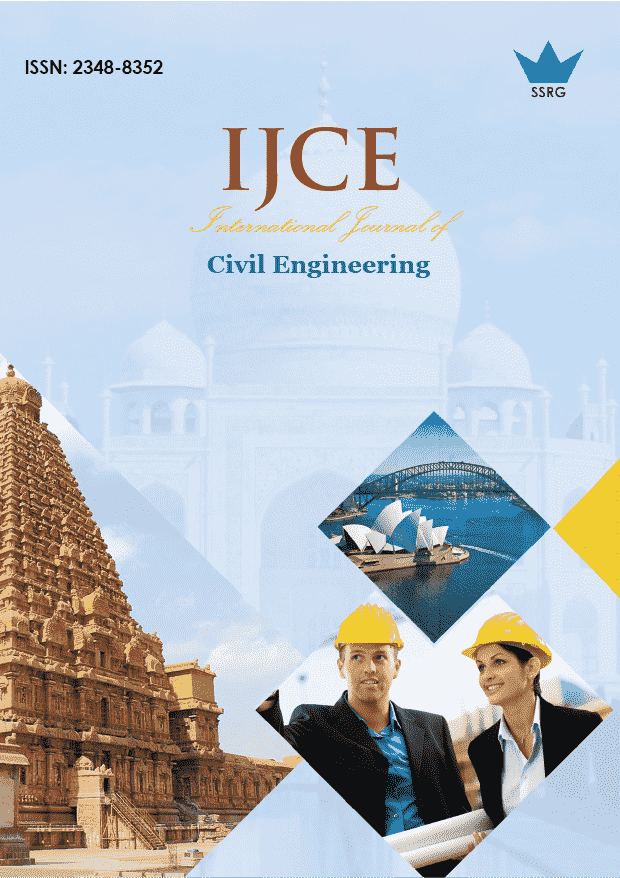Comparative Assessment of Embodied Carbon and Construction Cost in Concrete and Geotextile-Reinforced Retaining Walls

| International Journal of Civil Engineering |
| © 2025 by SSRG - IJCE Journal |
| Volume 12 Issue 10 |
| Year of Publication : 2025 |
| Authors : Riza Suwondo, Andryan Suhendra, Militia Keintjem, Mohammed Altaee |
How to Cite?
Riza Suwondo, Andryan Suhendra, Militia Keintjem, Mohammed Altaee, "Comparative Assessment of Embodied Carbon and Construction Cost in Concrete and Geotextile-Reinforced Retaining Walls," SSRG International Journal of Civil Engineering, vol. 12, no. 10, pp. 195-204, 2025. Crossref, https://doi.org/10.14445/23488352/IJCE-V12I10P116
Abstract:
The construction industry is a significant contributor to global carbon emissions. Concrete retaining walls are particularly high in embodied carbon because of their cement and steel components. As a response to rising sustainability challenges, geotextile-reinforced Mechanically Stabilised Earth (MSE) walls have recently been gaining popularity. This study offers an embodied carbon and cost analysis comparison of traditional cast-in-place Concrete Retaining Walls (CRW) and geotextile-reinforced MSE walls. These wall varieties were designed and assessed at 2, 4, 6, and 8 m heights and were kept under similar design and stability constraints. The Life Cycle Assessment (LCA) emissions accounting followed BS EN 15978, which covers stages A1 to A5, and the cost assessment utilised unit cost rates from the Indonesian Ministry of Public Works. MSE walls use a fraction of the high-embodied-carbon materials necessary for concrete retaining walls and thus have 98% less embodied carbon and are more environmentally beneficial. While MSE walls are less expensive to build at the lower design heights, the costs rise at the higher design heights because of the more expensive reinforced earth construction and excavation necessary. A trade-off analysis highlighted that MSE walls perform best in sustainability for low to medium-height applications, while CRWs are still cost-effective for high structures. This indicates that considering carbon and financial costs for retaining walls would anchor the design for sustainability-focused cross-reasoning in civil infrastructure frameworks.
Keywords:
Embodied Carbon, Retaining Wall Design, Mechanically Stabilised Earth Wall, Construction Cost Analysis, Life Cycle Assessment.
References:
[1] Martin Ziegler, “Application of Geogrid Reinforced Constructions: History, Recent and Future Developments,” Procedia Engineering, vol. 172, pp. 42 51, 2017.
[CrossRef] [Google Scholar] [Publisher Link]
[2] F. Tatsuoka et al., “Remedial Treatment of Soil Structures using Geosynthetic Reinforcing Technology,” Geotextiles and Geomembranes, vol. 25, no. 4 5, pp. 204 220, 2007.
[CrossRef] [Google Scholar] [Publisher Link]
[3] John B. Kennedy, Jan T. Laba, and Mostafa A. Mossaad, “Reinforced Earth Retaining Walls under Strip Load,” Canadian Geotechnical Journal, vol. 17, no. 3, pp. 382 394, 1980.
[CrossRef] [Google Scholar] [Publisher Link]
[4] Johanna Lehne, and Felix Preston, “Making Concrete Change Innovation in Low carbon Cement and Concrete,” Chatham House Report, pp. 1 122, 2018.
[Google Scholar] [Publisher Link]
[5] Paulo J.M. Monteiro, Sabbie A. Miller, and Arpad Horvath, “Towards Sustainable Concrete,” Nature Materials, vol. 16, pp. 698 699, 2017.
[CrossRef] [Google Scholar] [Publisher Link]
[6] Zhi Cao et al., “Decarbonizing Concrete: Deep Decarbonization Pathways for the Cement and Concrete Cycle in the United States, India, and China,” Technical Report, Industrial Sustainability Analysis Laboratory, Northwestern University, 2021. [Publisher Link]
[7] Mehdi Javadi et al., “Numerical Investigation on the Behaviour of Post Tensioned Mechanically Stabilised Earth Walls (PT MSEW),” Computers & Structures, vol. 299, pp. 1 22, 2024.
[CrossRef] [Google Scholar] [Publisher Link]
[8] Chikezie Chimere Onyekwena, and Huabei Liu, “Stability Analysis of Geotextile Reinforced Unsaturated Slope under Drawdown Conditions,” Geosystems and Geoenvironment, vol. 4, no. 4, pp. 1 14, 2025.
[CrossRef] [Google Scholar] [Publisher Link]
[9] Azmach Lole Gebeyehu, and Bappaditya Manna, “Recent Design Practice of Reinforced Earth Walls for High Speed Rail Transportation: A State of the art and Way Forward,” Engineering Science and Technology, an International Journal, vol. 55, pp. 1 15, 2024.
[CrossRef] [Google Scholar] [Publisher Link]
[10] Hyeong Joo Kim et al., “Analytical Model and Stress Behavior of Consolidated Load Bearing Geotextile Tubes,” Geotextiles and Geomembranes, vol. 53, no. 1, pp. 55 69, 2025.
[CrossRef] [Google Scholar] [Publisher Link]
[11] Rahul Shende et al., “Engineering Assessment of Reinforced Earth Wall and Vehicular Underpass Sections in a Six Lane Highway: Analysis, Causes, and Remedial Measures,” Case Studies in Construction Materials, vol. 22, pp. 1 22, 2025.
[CrossRef] [Google Scholar] [Publisher Link]
[12] M. Sarath Babu, A. Victor Samson Raj, and M. Manoj Kumar, “Slope Stability Evaluation of Geosynthetic Reinforced Soil,” International Journal of Recent Technology and Engineering (IJRTE), vol. 8, no. 4, pp. 7143 7147, 2019.
[CrossRef] [Publisher Link]
[13] Veerabhadra M. Rotte, and Hardik V. Gajjar, “Influence of Reinforcement Pattern on the Performance of Geotextile Reinforced Slopes,” Advances in Computer Methods and Geomechanics, pp. 397 408, 2020.
[CrossRef] [Google Scholar] [Publisher Link]
[14] Ming Zhu et al., Slope Stability Charts for Stacked Geotextile Tubes, ProceedingsGeo Congress, 2014.
[CrossRef] [Google Scholar] [Publisher Link]
[15] Hardik V. Gajjar, and Veerabhadra M. Rotte, “A Numerical Study on Geotextile Reinforced Slopes,” Proceedings of the Indian Geotechnical Conference 2019, pp. 775 784, 2021.
[CrossRef] [Google Scholar] [Publisher Link]
[16] Roland Bechmann, and Werner Sobek, “Reducing the Carbon Emissions of High Rise Structures from the Very Beginning,” CTBUH Journal, no. 4, pp. 30 35, 2021.
[Google Scholar] [Publisher Link]
[17] Stephan A. Jefferis, Moving Towards Sustainability in Geotechnical Engineering, Proceedings GeoCongress 2008, pp. 844 851, 2012.
[CrossRef] [Google Scholar] [Publisher Link]
[18] Charakho N. Chah, Sreedeep Sekharan, and Vimal Katiyar, “Geotechnical Characterisation and Sustainability Assessment of Plastic Waste Inclusions on a Cement Treated Fine Grained Soil for Pavement Applications,” Transportation Geotechnics, vol. 51, 2025.
[CrossRef] [Google Scholar] [Publisher Link]
[19] Ali Akbar Firoozi, Ali Asghar Firoozi, and Mohammad Reza Maghami, “Sustainable Practices in Geotechnical Engineering: Forging Pathways for Resilient Infrastructure,” Results in Engineering, vol. 26, pp. 1 30, 2025.
[CrossRef] [Google Scholar] [Publisher Link]
[20] Araz Hasheminezhad, Halil Ceylan, and Sunghwan Kim, “Advances in Innovative Sustainable Transportation Geotechnics,” Transportation Geotechnics, vol. 49, 2024.
[CrossRef] [Google Scholar] [Publisher Link]
[21] Phillip Zastrow et al., “Life Cycle Assessment of Cost Optimized Buttress Earth Retaining Walls: A Parametric Study,” Journal of Cleaner Production, vol. 140, pp. 1037 1048, 2017.
[CrossRef] [Google Scholar] [Publisher Link]
[22] Joaquín J. Pons et al., “Life Cycle Assessment of Earth Retaining Walls: An Environmental Comparison,” Journal of Cleaner Production, vol. 192, pp. 411 420, 2018.
[CrossRef] [Google Scholar] [Publisher Link]
[23] Luiz Paulo Vieira de Araújo Junior, Cristiane Bueno, and Jefferson Lins da Silva, “Life Cycle Assessment and Circularity Indicators of Earth Retaining Walls and Mechanically Stabilized Earth,” Sustainability, vol. 17, no. 9, pp. 1 22, 2025.
[CrossRef] [Google Scholar] [Publisher Link]
[24] G. Heerten, “Reduction of Climate Damaging Gases in Geotechnical Engineering Practice using Geosynthetics,” Geotextiles and Geomembranes, vol. 30, pp. 43 49, 2012.
[CrossRef] [Google Scholar] [Publisher Link]
[25] Matthias Stucki et al., “Comparative Life Cycle Assessment of Geosynthetics Versus Conventional Construction Materials,” Report, European Association for Geosynthetic Manufacturers, pp. 1 105, 2011.
[Google Scholar]
[26] S.D. Rafalko, J.E. Sankey, and N. Freitag, “Sustainability Measures for MSE Walls and Baseline EnvironmentalImpact, Evaluations,” Earth Retention Conference 3, pp. 486 493, 2012.
[CrossRef] [Google Scholar] [Publisher Link]
[27] Standar Nasional Indonesia, “SNI 2052:2017: Concrete Reinforcement Steel,” Badan Standardisasi Nasional, pp. 1 19, 2017.
[Google Scholar] [Publisher Link]
[28] Standar Nasional Indonesia, “SNI 8460:2017: Geotechnical Design Requirements,” Badan Standardisasi Nasional, pp. 1 323, 2017.
[Google Scholar]
[29] EN 15978 (2011) Sustainability of Construction Works Assessment of Environmental Performance of Buildings Calculation Method, BSI, 2011.
[Google Scholar] [Publisher Link]
[30] “The Inventory of Carbon and Energy (The ICE Database),” Circular Ecology, 2020.
[Google Scholar] [Publisher Link]
[31] O P. Gibbons, J.J. Orr, and W. Arnold, How to Calculate Embodied Carbon, 1st ed., Institution of Structural Engineers, pp. 1 45, 2022.
[Google Scholar] [Publisher Link]
[32] Whole Life Carbon Assessment for the Built Environment, 1st ed., Royal Institute of Chartered Surveyors, Professional Standards and Guidance, pp. 1 41, 2017.
[Publisher Link]

 10.14445/23488352/IJCE-V12I10P116
10.14445/23488352/IJCE-V12I10P116